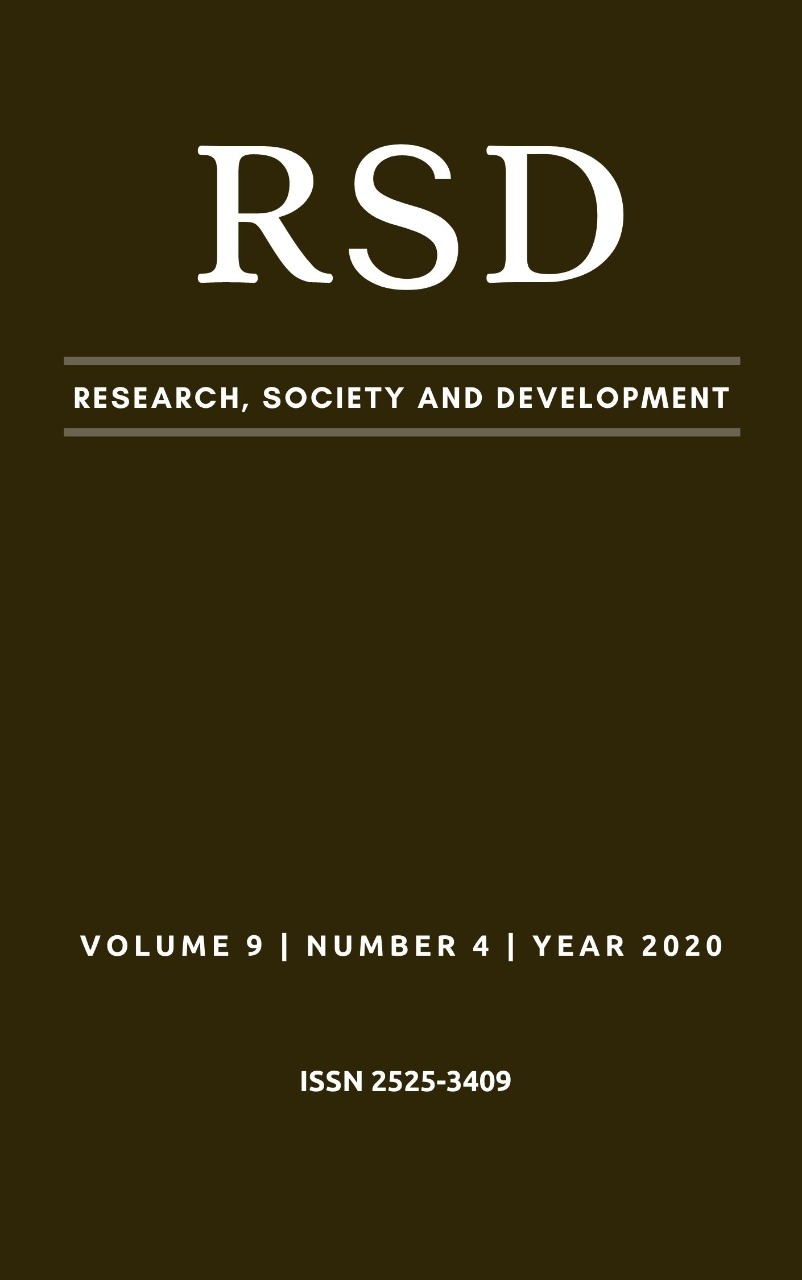Influência das variáveis climáticas no incremento diamétrico de Bauhinia forficata Link, Mimosa scabrella Benth. e Schinus terebinthifolius Raddi
DOI:
https://doi.org/10.33448/rsd-v9i4.2859Palavras-chave:
Fatores climáticos, Anéis de crescimento, Dendrocronologia.Resumo
Este trabalho verificou a influência das variáveis climáticas no incremento diamétrico das espécies florestais Schinus terebinthifolius Raddi., Mimosa scabrella Benth. e Bauhinia forficata Link em uma floresta em processo de recuperação implantada no ano de 2007, em Guarapuava, Paraná. Foram amostradas 43 árvores da espécie S. terebinthifolius, 38 da espécie M. scabrella e 30 da espécie B. forficata. Foram retiradas duas amostras de cada árvore, os anéis de crescimento foram marcados e mensurados com o Software Image J, as medidas foram submetidas ao controle de qualidade com o Software Cofechae as cronologias geradas com o Software Arstan. As variáveis climáticas foram evaporação, insolação, precipitação anual (mm), temperatura máxima, média e mínima (ºC) e umidade relativa, obtidas para o período de 2007 a 2018, disponibilizados pela estação meteorológica da Universidade Estadual do Centro-Oeste - UNICENTRO, Guarapuava – PR. Foi utilizada a Correlação de Pearson, a análise fatorial e de componentes principais para verificar a relação entre as variáveis climáticas e o incremento. Os resultados mostraram correlação significativa positiva do incremento em diâmetro da espécie B. forficata e S. terebinthifolius com as variáveis evaporação, precipitação, temperatura máxima, média e mínima e negativa com as variáveis insolação e umidade relativa. A espécie M. scabrella apresentou correlação significativa positiva com as variáveis evaporação, precipitação e temperatura mínima, e negativa com as variáveis insolação e umidade relativa e não apresentou correlação significativa com as variáveis temperatura máxima e média. Os anos característicos de altos e baixos crescimentos são os mesmos para as três espécies, que demonstraram alta correlação entre as cronologias e alta sensibilidade aos fatores climáticos. As variáveis precipitação e temperatura influenciaram no crescimento das espécies. O incremento médio do diâmetro para M. scabrella foi 1,51 cm.ano-1, 1,09 cm.ano-1 para S. terebinthifolius e 0,73 cm.ano-1 para B. forficata. Devido às condições da área de estudo em função das ações antrópicas, recomenda-se ações como isolamento físico da mesma, de modo que se favoreça a manutenção dos processos ecológicos naturais da floresta. Estudos sobre a dendrocronologia de árvores que foram implantadas em ambientes degradados e submetidos à recuperação são necessários para compreender a relação do crescimento das espécies florestais com os fatores climáticos e a sua importância para a manutenção das funções ecológicas no local.
Referências
Amaral Machado, S.; Souza, R. F.; Teophilo Aparecido, L. M.; Ribeiro, A.; Czelusniak, B. H. (2015). Evolução das variáveis dendrométricas da bracatinga por classe de sítio. CERNE, Lavras, 21 (2), 199 – 207. doi: 10.1590/01047760201521021222
Bamberg, R. (2014). Análise da influência das variáveis meterorológicas no crescimento em diâmetro e altura de quatro espécies florestais. Dissertação (Mestrado em Engenharia Florestal - Universidade Federal do Paraná, Curitiba.
https://acervodigital.ufpr.br/handle/1884/36988
Da Silva, L. C. R.; Machado, S. A.; Galvão, F.; Figueiredo Filho, A. (2016). Evolução estrutural de bracatingais da região metropolitana de Curitiba, Paraná, Brasil. Ciência Florestal, 26, 171-179. doi: 10.5902/1980509821102
Kanieski, M. R.; Galvão, F.; Roig, F. A.; Botosso, P. C. (2017). Dendroecologia de Sebastiania commersoniana (Baill.) L. B. Sm. & Downs e Hovenia dulcis Thunb. em uma área degradada na Floresta Ombrófila Mista Aluvial no Sul do Brasil. Ciência Florestal, 27(4), 1201 – 1215. doi: 10.5902/1980509830303
Souza, F. R.; Machado, S. A.; Galvão, F.; Figueiredo Filho, A. (2017). Effect of environmental variables in the distribution od tree species in the Iguaçu national park. Revista Árvore, 41. doi: 10.1590/1806-90882017000600009
Downloads
Publicado
Edição
Seção
Licença
Autores que publicam nesta revista concordam com os seguintes termos:
1) Autores mantém os direitos autorais e concedem à revista o direito de primeira publicação, com o trabalho simultaneamente licenciado sob a Licença Creative Commons Attribution que permite o compartilhamento do trabalho com reconhecimento da autoria e publicação inicial nesta revista.
2) Autores têm autorização para assumir contratos adicionais separadamente, para distribuição não-exclusiva da versão do trabalho publicada nesta revista (ex.: publicar em repositório institucional ou como capítulo de livro), com reconhecimento de autoria e publicação inicial nesta revista.
3) Autores têm permissão e são estimulados a publicar e distribuir seu trabalho online (ex.: em repositórios institucionais ou na sua página pessoal) a qualquer ponto antes ou durante o processo editorial, já que isso pode gerar alterações produtivas, bem como aumentar o impacto e a citação do trabalho publicado.


